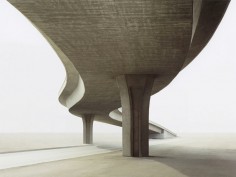JOSEF SCHULZ
source: complex
Photographer Josef Schultz has an amazing ability to manipulate buildings until they are reduced to their simplest pictorial forms. In his work “Sachliches” and “formen” Schulz actually removes the building’s surrounding landscapes from the images, forcing a stark graphic appearance.
.
.
.
.
.
.
.
source: sherhaanru
Josef Schulz — «фотограф» современных складских помещений, заводов и банальных зданий промышленного назначения, которые, по мнению подавляющего большинства, не имеют ни малейшей архитектурной ценности. Такие здания возводятся по всему свету едва не за идентичными строительными планами и применяются в разнообразных промышленных отраслях. По их внешнему виду почти невозможно определить их назначение, а фасады отличаются разве что материалом отделки.
.
.
.
.
.
.
.
source: wpkaiaktw
1966 年生於波蘭的德國攝影師 Josef Schulz 擅長拍攝工業建築、建築以及景觀攝影作品,他的作品呈現了大型建築的美麗線條,他的簡約風格構圖避免了我們對建築結構的批判眼光,而單純的帶出當代建築的純粹之美。他的作品更進一步的提出了現代攝影師是否能夠在世俗的本質上尋找出新的美學觀點
.
.
.
.
.
.
.
source: josefschulz
osef Schulz is a “photographer” of modern warehouses and factories – trite industrial buildings that nobody would want to consider to be of any major architectural interest. All over the world these buildings are mass-produced, built for all kinds of industrial production processes using identical plans and blueprints. Their exteriors offer no hint whatsoever of the specific purposes for which they are used, their façades vary only in terms of the materials selected – all of them pre-fabricated, such as slabs of concrete, corrugated sheet metal and other cheap building materials.
Josef Schulz does not aim at exposing this architecture in any way nor does he want to venture into a critical analysis of its appearance. He simply uses the photographs of the buildings to study the grammar of his trade. Schulz starts by taking traditional photographs of the halls, storage facilites and industrial structures with large sized photographic plates. Using digital image processing, the analogue picture produced is then “cleansed” of the few remaining hints pointing to age, location or environment of the buildings. All details that might possibly allow conclusions concerning the actual size, users, time or place of the buildings are completely removed. The physical reality of the buildings is changed in such a way that they seem to become virtual blueprints designed to perfection. Schulz focusses on colours and shapes reducing them to simple block-like structures. Particular emphasis is given to symmetries, colour contrasts and the overall structure of the image: they thus become dominant components of the picture. The buildings now ressemble toy architecture; they suddenly appear to be benign counterparts of themselves.
He uses this type of processing to eliminate the gap between “photographic” and “painted” reality for the benefit of optimizing the picture. At the same time, he reverses the photographic process by reducing the physical buildings to their design concepts and the photographically “real” picture to its original “virtual” one. Schulz thus opts for an approach that is diametrically opposed to that of producers of digital images – to make the rendering of artificial pictures appear as real as possible. The viewer is somewhat confused: he seems to recognize parts that appear to be authentic without being able to distinguish whether they were truly located before the camera or generated with the tools of digital image processing. By doing so, Josef Schulz distances himself from the “objectivity” of photography and shows that pictures are always the construct of the visual power of imagination of the artist.
.
.
.
.
.
.
.
source: josefschulz
Josef Schulz “fotografiert” moderne Lager- und Fertigungshallen. Es sind banale Industriebauten, denen man nur wenig architektonisches Interesse entgegenbringen möchte. Sie werden überall auf der Welt rationell und nach immer dem gleichen Muster für verschiedenste industrielle Produktionsabläufe gebaut. Ihre spezifische Nutzung ist von Außen nicht zu erkennen, die Variationen der Fassadengestaltung beschränken sich auf eine Auswahl industriell vorgefertigter Materialien, wie Betonplatten, Wellblech und anderen billigen Baustoffen.
Josef Schulz will diese Architektur nicht bloßstellen oder eine kritische Studie ihres Erscheinungsbildes vornehmen. Die Aufnahmen der Gebäude dienen ihm lediglich als Ausgangsmaterial für eine Untersuchung der Grammatik seines Metiers. Die Hallen, Lagerplätze und industriellen Strukturen fotografiert er zunächst traditionell mit einer großformatigen Plattenkamera. Das entstandene analoge Foto wird dann von ihm mit Hilfe digitaler Bildbearbeitungtechniken von den wenigen Hinweisen auf Umgebung, Alter und Ort der Gebäude “gereinigt”. Alle Details, die Aufschluss über die Größenverhältnisse, die Nutzer oder das räumliche oder zeitliche Umfeld der Gebäude geben könnten, werden entfernt. Er verändert die real vorhandenen Gebäude in einer Weise, daß sie zu scheinbar konstruierten, virtuellen Entwürfen werden. Dabei werden ihre Farbigkeit und ihre mehr oder weniger auf einfache Quader reduzierten Formen verstärkt in den Vordergrund gerückt. Symmetrien, Farbkontraste und Bildaufbau werden hervorgehoben und als wichtige Bildkomponenten ausgezeichnet. Die Gebäude selbst erinnern nun mehr an Spielzeugarchitektur und wirken wie der freundliche Widerpart ihrer selbst.
Mit dieser Art der Bearbeitung hebt er bewußt die Schwelle zwischen “fotografischer” und “malerischer Realität” zugunsten der Bildoptimierung auf. Gleichzeitig kehrt er den fotografischen Prozess um, indem er die in der Wirklichkeit gebauten Gebäude auf ihre Konstruktionsidee und das fotografisch-reale Bild auf sein “ursprüngliches” virtuelles Bild zurückführt. Josef Schulz geht damit einen, den digitalen Bildproduzenten entgegengesetzten Weg, nämlich artifizielle Bilder möglichst wirklichkeitsgetreu zu rendern. Der Betrachter wird irritiert, da er letzte Reste des Authentischen im Bild zwar noch vermeintlich erkennt, aber nicht mehr unterscheiden kann, ob diese vor der Kamera waren oder mit den Werkzeugen des digitalen Bildprogrammes erstellt wurden. Josef Schulz rückt damit von der “Objektivität” des fotografischen Bildes ab und zeigt, daß im Grunde jedes Bild ein Konstrukt der visuellen Vorstellungskraft des Künstlers ist.


